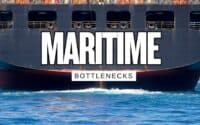Autonomous Ships: 12 Significant Concerns

Autonomous ships are rapidly becoming a buzzword in the maritime industry, with many experts touting them as the future of shipping. By leveraging cutting-edge technology, these vessels promise significant benefits that could revolutionize global trade. Some of the obvious advantages include:
- Cost Efficiency: Reduction in crew costs, potentially saving up to 30% of operational expenses.
- Enhanced Safety: Elimination of human error, which accounts for approximately 75-96% of maritime accidents.
- Increased Efficiency: Improved route optimization and fuel efficiency through real-time data analysis.
While these benefits are promising, the road to fully autonomous shipping is fraught with challenges. Below, we delve into 12 significant concerns.
1. Cybersecurity Risks 🛡️
As ships become increasingly digitized, they are also more vulnerable to cyberattacks. Hackers could potentially take control of an autonomous vessel, causing financial losses, environmental damage, or even jeopardizing lives.
Key Concerns:
- Data Breaches: Autonomous ships rely heavily on data exchange with shore-based control centers. Unauthorized access to this data could disrupt operations or reveal sensitive trade routes.
- Ship Hijacking: Cyberattacks could lead to remote control of a vessel by malicious actors, leading to potential ransom demands.
- System Downtime: Malware or viruses could render critical navigation and operational systems inoperable, leading to delays and increased costs.
Real-World Example:
- In 2017, a cyberattack on a vessel caused an estimated $300 million in damages. An autonomous ship, with its heavy reliance on digital systems, could be an even more attractive target.
2. Regulatory and Legal Challenges ⚖️
The transition to autonomous shipping faces a maze of regulatory and legal uncertainties. The lack of uniform global standards for autonomous ships creates significant barriers for their adoption.
Key Concerns:
- Liability in Accidents: Determining who is at fault—manufacturer, software developer, or operator—is a complex issue in autonomous ship incidents.
- Flag State Jurisdiction: Autonomous vessels may face difficulties adhering to varying maritime laws across different jurisdictions.
- Certification Standards: There is currently no universal framework for certifying autonomous vessels, which could delay their deployment.
Real-World Example:
- The International Maritime Organization (IMO) has begun developing guidelines for Maritime Autonomous Surface Ships (MASS), but these are still in early stages. This regulatory gap could slow down commercial adoption for years.
3. Integration with Existing Fleet Infrastructure ⚙️
One of the most immediate hurdles is integrating autonomous vessels into fleets that rely on traditional manned ships. Mixed fleets present operational and logistical challenges that can impact efficiency.
Key Concerns:
- Communication Barriers: Autonomous ships need seamless communication with manned vessels, shore facilities, and ports, which is difficult with existing technology.
- Port Compatibility: Current port infrastructure is often designed for human-operated ships, requiring significant upgrades to handle autonomous vessels.
- Maintenance: Autonomous ships demand specialized maintenance that traditional crews and facilities may not yet be equipped to provide.
Potential Costs:
- Retrofitting ports and fleet operations to accommodate autonomous vessels could cost millions per facility, depending on the scale of operations.
4. Reliability of Autonomous Technology 🤖
Despite advancements, autonomous systems are not infallible. Technology malfunctions or unexpected situations could compromise safety and operational efficiency.
Key Concerns:
- Sensor Failures: Radar, lidar, and other sensors used for navigation can fail due to extreme weather, physical obstructions, or technical glitches.
- Unexpected Scenarios: Autonomous systems struggle with unpredictable events, such as uncharted debris or erratic behavior from other vessels.
- Redundancy Requirements: To ensure safety, autonomous ships require backup systems, increasing costs and complexity.
Real-World Challenge:
- An Autonomous Ship encountered technical issues during a transatlantic trial in 2022, highlighting the need for more robust systems before widespread adoption.
5. Workforce Impact and Resistance 💼
The shift to autonomous ships could disrupt maritime employment, leading to resistance from crews and unions while creating new challenges for workforce management.
Key Concerns:
- Job Losses: Automation could eliminate roles traditionally held by seafarers, leading to widespread job displacement in the maritime sector.
- Skills Gap: The industry will need workers skilled in advanced technology and remote operations, which requires substantial retraining efforts.
- Union Opposition: Resistance from maritime unions could delay the adoption of autonomous technology through strikes or lobbying against regulations.
Data Point:
- Studies estimate that over 1.6 million seafarers worldwide could be affected, with many needing retraining for advanced roles.
6. Emergency Response Limitations 🚨
Autonomous ships face significant challenges in handling emergencies, particularly when human decision-making and intervention are critical.
Key Concerns:
- Collision Avoidance: Autonomous ships rely on algorithms and sensors that might not react appropriately in complex scenarios involving other vessels or obstacles.
- Fire or Flooding: Without onboard crew, responding to onboard emergencies like fires or flooding becomes much more difficult.
- Rescue Operations: In emergencies requiring life-saving measures, the absence of a crew limits the ability to assist other vessels or passengers.
Real-World Consideration:
- The International Maritime Rescue Federation (IMRF) has raised concerns about the ability of autonomous ships to contribute to or request search and rescue operations during maritime disasters.
7. High Initial Investment Costs 💰
Deploying autonomous ships requires a substantial upfront investment, which may deter shipowners from adopting the technology, particularly in a volatile shipping market.
Key Concerns:
- Development Costs: Designing, building, and testing autonomous ships involve high R&D expenses, often running into tens or hundreds of millions of dollars.
- Fleet Retrofitting: Existing vessels require extensive and costly modifications to integrate autonomous technology.
- Economic Uncertainty: Owners may hesitate to invest due to fluctuating shipping demand and unproven ROI (Return on Investment) for autonomous operations.
Example Cost Breakdown:
- Retrofitting a medium-sized cargo ship with autonomous technology can cost $7–10 million, depending on the level of autonomy and existing ship condition.
8. Environmental Impact 🌊
Autonomous ships can potentially reduce emissions through optimized routes, but there are concerns about the broader environmental impact of their adoption.
Key Concerns:
- Manufacturing Impact: Building new autonomous vessels or retrofitting old ones requires energy-intensive manufacturing processes.
- Battery Technology: Many autonomous ships are exploring electric propulsion, but large batteries can be difficult to recycle and have significant environmental costs.
- Unforeseen Spill Risks: If an autonomous ship’s systems fail and cause a spill, the lack of human oversight might exacerbate environmental damage.
Relevant Data:
- Some estimates suggest that manufacturing batteries for large autonomous ships could generate up to 40% more CO2 than conventional propulsion systems over the same lifecycle.
9. Scalability Challenges 📈
Scaling autonomous shipping across the global maritime industry presents significant logistical and operational hurdles.
Key Concerns:
- Fleet Compatibility: Integrating autonomous ships into existing fleets without disrupting operations can be challenging, particularly for small to medium-sized operators.
- Global Implementation: Autonomous ships must comply with various international standards and local port requirements, which are not yet uniform.
- Infrastructure Readiness: Many ports and shipyards are not equipped to handle autonomous technology, necessitating large-scale upgrades.
Data Point:
- Studies estimate that upgrading port infrastructure globally to support autonomous operations could cost $1 trillion over the next two decades.
10. Data Management and Bandwidth Needs 📡
Autonomous ships rely on massive amounts of real-time data for navigation, communication, and operations, creating unique challenges in data management.
Key Concerns:
- Bandwidth Limitations: Transmitting large volumes of data between ships and shore-based control centers requires robust, high-speed communication networks, especially in remote areas.
- Data Storage: Autonomous systems generate vast amounts of operational data that must be securely stored and analyzed for decision-making and compliance.
- Cybersecurity Risks: The more data transmitted and stored, the higher the risk of breaches and unauthorized access.
Real-World Example:
- The maritime industry’s shift to using satellites for faster internet has improved data transmission but significantly increased operational costs, with subscriptions averaging $5,000–$15,000/month per ship.
11. Insurance and Liability Complexities 📑
The shift to autonomous ships creates significant challenges for insurers, potentially driving up costs or limiting coverage options.
Key Concerns:
- Policy Adjustments: Current maritime insurance policies are designed for crewed ships. Insurers must create new frameworks for autonomous operations.
- Higher Premiums: Insurers may charge more due to the untested nature of autonomous technology and the complexity of liability.
- Legal Gray Areas: Determining liability in accidents involving autonomous ships (e.g., software malfunctions vs. manufacturer faults) complicates claims processing.
Relevant Data:
- Early autonomous ship insurance policies have premiums estimated to be 20–30% higher than those for crewed ships due to increased uncertainty.
12. Public Perception and Trust 🛳️
The success of autonomous ships depends heavily on gaining trust from the public, stakeholders, and regulatory bodies.
Key Concerns:
- Perceived Risks: High-profile accidents or cybersecurity breaches could erode trust in autonomous shipping technology.
- Resistance from Stakeholders: Some shipowners, seafarers, and unions may view automation as a threat to jobs and industry traditions.
- Customer Hesitation: Cargo owners and logistics companies may hesitate to rely on autonomous vessels until the technology is widely proven.
Real-World Parallel:
- The aviation industry faced similar challenges with autonomous features in commercial aircraft. Even today, fully autonomous flights have not been widely adopted due to safety and trust concerns.
Autonomous ships promise to offer benefits such as cost savings, increased efficiency, and enhanced safety. However, the challenges cannot be ignored. From cybersecurity risks and regulatory hurdles to workforce displacement and public perception, these concerns must be addressed to ensure the successful integration of autonomous technology into the global fleet.
For ship and fleet owners, the road to automation requires careful planning, substantial investment, and a commitment to navigating the complexities of this cutting-edge technology. As the industry evolves, the key to success lies in balancing innovation with practicality, ensuring that both human and technological elements work together to propel the future of maritime shipping forward.

Do you have a Maritime Product or Service that may be of interest to Shipowners? Tell us about it here!
Do you have feedback or insights? Please reach out to editor @ shipuniverse.com



